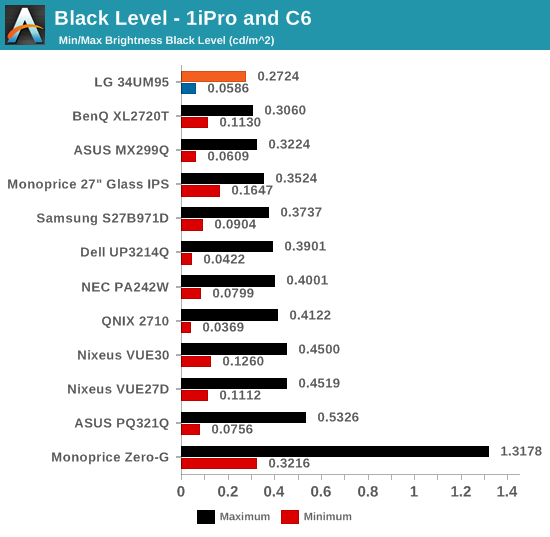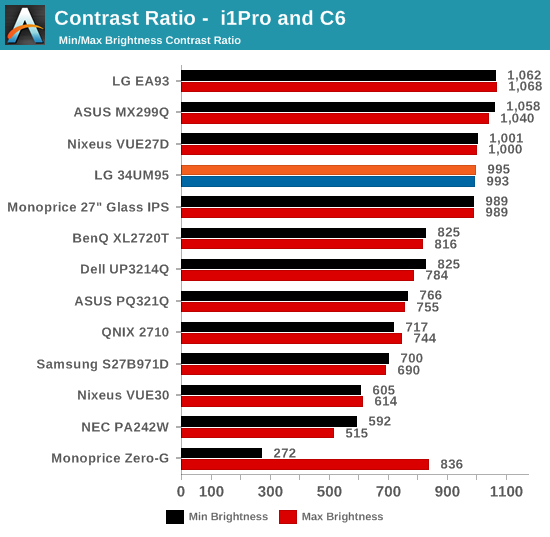LG 34UM95 Monitor Review
by Chris Heinonen on June 18, 2014 7:00 AM ESTAll measurements are done using CalMAN 5.3 from SpectraCal and a custom workflow. An i1Pro and C6 meters are used to measure accurate colors and low light levels. For all test patterns I use APL 50% when possible to prevent backlight tricks and other things from skewing the results. Full field test patterns are used with the display uniformity testing.
With the backlight set to minimum the LG 34UM95 puts out 55 cd/m2 of light. That is a good number that is low enough to work for any dark environment, but not so low that you can’t use it. The brightness control operates in 1% steps giving you lots of room for adjustment. The maximum light level is 270 cd/m2. This is a bit lower than I would like to see, as direct sunlight will still wash things out, but it is decent. Most people likely will pick a setting in the middle of these and the brightness adjustment makes it easy to get the level you want.

Black levels are also very good. The minimum black level achieved is 0.0586 cd/m2 and the maximum level is 0.2724 cd/m2. The 21:9 monitors have been very good so far at getting low black levels and the 34UM95 is no exception.

These combine to give us a contrast ratio very close to 1,000:1. As this is now what I consider to be acceptable in a good IPS display, the LG 34UM95 does not disappoint.

So far, so good for the 34UM95. Let's move on to the color accuracy.










110 Comments
View All Comments
Samus - Wednesday, June 18, 2014 - link
So is every other corporate grade monitor. My 24" Dreamcolor Display cost $2000 a few years ago.marcosears - Thursday, October 9, 2014 - link
I agree. Most people will want to get one of the top monitors at a more reasonable price range. /Marco from http://www.consumertop.com/best-monitor-guide/evilspoons - Wednesday, June 18, 2014 - link
I don't understand the attraction some people have to 4:3 monitors. Human vision is naturally "widescreen" and looking up and down is much less comfortable than looking left and right. Natural selection 'trained' us to look along the horizon, not up and down. Our retina may be 4:3, but it's not like a single monitor encompasses our entire field of view... now, talk about selecting an LCD panel for a VR display like the Oculus Rift and 4:3 will have my complete support...DanNeely - Wednesday, June 18, 2014 - link
For anything text related, wider lines are harder to read; so making the screen wider doesn't bring a benefit; but wider screens tend to be shorter meaning that fewer lines of text can be shown at a time.bigboxes - Wednesday, June 18, 2014 - link
I have a 16:10 monitor, but I don't run MS Word or my browser at full screen. I size the windows ~4:3. I have room to move things around and watch video in widescreen. I think that 21:9 @1440 is great. Two full size windows on one screen instead of two 20" monitors with a bezel between them. It's niche, but not for enthusiasts.TegiriNenashi - Wednesday, June 18, 2014 - link
"Human vision is naturally "widescreen" "That widescreen propaganda is wrong, human vision is close to 4:3:
http://en.wikipedia.org/wiki/Human_eye#Field_of_vi...
Short screens are ridiculous waste of pixels on the sides.
TegiriNenashi - Wednesday, June 18, 2014 - link
Here is verbatim quote: "The approximate field of view of an individual human eye is 95° away from the nose, 75° downward, 60° toward the nose, and 60° upward"Let's do arithmetic, shall we? (95+95)/(75+60)=1.4Let me put it this way. Humans have 2 (two) eyes. Each eyeball is round. Even if both eyes vision didn't overlap, the maximally wide FOV covered by two eyes would be two adjacent squares. Which makes the aspect ratio to 2:1 max. However, non-overlapping view this is extreme scenario, more applicable to lower species (such as fish).
To summarize, 2.35:1 is ridiculous invention from previous century. The framing of most scenes in movies is awkward, with actors top of the forehead chopped off. Hollywood should kill it once and for all.
Sabresiberian - Wednesday, June 18, 2014 - link
No, human vision is not "naturally widescreen". It isn't just the retina alone that determines field of view, and normal field of view is 4:3. Also, I don't know why you would have more trouble looking up and down than side to side - I certainly don't.Your comment about "natural selection" - you are just making that up. Personally, I'm a big fan of watching where I put my feet, that doesn't involve looking at the horizon. I think that's pretty much normal, but maybe I'm wrong.
You are confusing societal conditioning with the fundamental man. If you lived in a different kind of society, one that hunted animals in trees, for example, your conditioning would be entirely different, and you wouldn't think "wide-screen" was so "natural" because it would be "natural" for you to look above you as much as to the side. Movies are made wide-screen because of the limitations of seating arrangements for audiences more than anything else. There are scenes in which that view works well - like looking at a horizon with an unobstructed view, say from the deck of a ship or a mountain top, but there are areas where the wide screen utterly fails, as in the experience of walking down a city street between tall buildings.
Movies largely turn us into floating entities without feet living in a sky-less world. It isn't natural, we are just conditioned to it.
Ktracho - Wednesday, June 18, 2014 - link
I may be betraying my age, but on my 30" 2560x1600 display + 24" 1920x1200 display set up, it is much easier for me to look at the bottom half of the display than the top half, and in fact, I prefer moving my head sideways a greater distance (towards the 24" display) than tilting it up. If it's just for a few seconds then it's not a big deal, but for longer periods of time, my body definitely has a preference.Also, I'm not sure field of view is the relevant thing to measure. Even if I were to only use a 24" or a 20" display, I am not trying to see the entire display as a whole, but a specific area at a time, so length:width ratio of the display is not significant. Length:width ratio of the window I am focusing on is far more significant, especially in terms of readability of text. Watching videos full screen or playing games would be a different matter, of course.
I suspect for my scenario/working habits, a wider display (which allows moving less frequently-used windows off to the side) would be preferable to a taller but narrower display, requiring me to tilt my head more often (or waste real estate), as well as to having a dual-display set up as in my current one.
MrSpadge - Thursday, June 19, 2014 - link
I seconds this, although with "just" one 16:9 or 16:10 monitor. I tend to put things I focus on at about the same height, independnet of how much space is left above and below it.